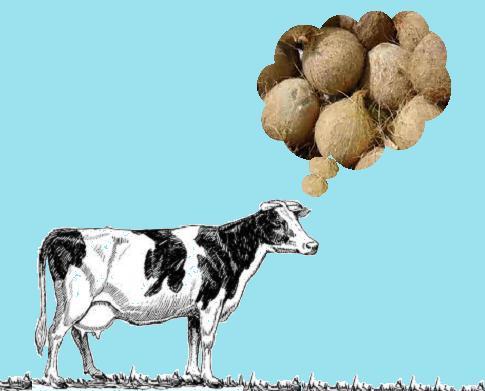Coconut is not really a children’s flavor. It was definitely my least favorite flavor growing and I wasn’t alone in feeling this way.
Whenever a parent brought a box of donuts to a childrens event, a morning baseball game or a pre-dawn field trip to the tide pools, the last one left in the box was always the coconut. It made perfect sense to me.
Of course, someone would eventually eat the donut anyway because, well, it was a donut. And we were all quite used to scraping stuff off our food—the black part of a burnt piece of toast, the bruised part of a banana, and the coconut on anything.
What I didn’t understand was those “Sometimes You Feel Like a Nut” commercials for PeterPaul candy bars. The concept was all about choosing the chocolate bar that had almonds (Almond Joy) versus the one that didn’t have almonds (Mounds). Hence the “sometimes you feel like a nut, sometimes you don’t” jingle. The problem was that both of them had dense coconut filling which made them pretty much unpalatable either way. The presence of almonds was completely beside the point.
Oh, I know. There was always the one kid who actually liked coconut, but those were Children In Name Only (or Chinos) and are probably in a therpist’s office right now bemoaning their lost childhoods.
Just kidding.
Actually, it turns out those Chinos were right about coconut and the rest of us were wrong. It’s great. So good, in fact, that in the non-dairy frozen dessert world, it makes a terrific substitute for ice cream. Because coconuts come from the tropics, they’re rich in saturated fats just like cream which makes them smooth, delicious and, well, creamy.
If you haven’t tried coconut-based “ice cream,” I heartily recommend it. I also vow to bring you recipes for it here before too long.
For now all I’ve got is Pina Colada ice cream, which is not going to satisfy my friends who can’t put up with lactose, but it’s pretty darned good and, while not completely non-dairy, it is dramatically lower dairy.
NOTE: If you’re like me, you may have thought the pina in pina colada stood for the pineapple while the colada represented the coconut. It turns out that colada means strained. So this drink is called strained pineapple with no credit whatsoever for the coconut. Not on my watch!
The key to this dessert, the golden pathway to cream-free ice cream is coconut milk. But that will have to come later. This time around I just substituted light coconut milk it for the whole milk in “Grandma’s Old-Fashioned” custard recipe and used cream for the remainder of the ice cream base. This created an inherent coconut flavor in the ice cream which I then balanced out with fresh pineapple which turned the whole thing into pina colada.
The family liked this flavor well enough but they were not blown away by it. This could be because my kids are, well, kids, which means they don’t like coconut.
Maybe I should have thought of that beforehand.
Pina Colada Ice Cream
(about 2 quarts)
1 ½ cups coconut milk
¾ cup sugar
2 T flour
A few grains salt
2 eggs or 3 yolks (pasteurized, if possible, see note)
1 ½ cup cream
1 ½ cups fresh pineapple
- Heat coconut milk to 180-190ºF with sugar, flour and salt, stirring until thick, cover for 10 minutes.
- Beat eggs and add ½ cup of mixture while beating, then add eggs to mixture.
HEALTH NOTE: Since you’re dealing with eggs here, you need to take care when cooking the custard. Too much cooking and the custard gets lumpy, too little and you risk salmonella. Another alternative is to use pasteurized eggs.
- Heat the mixture for one minute over medium, then cool with plastic wrap or wax paper pressed onto the top of the mixture to keep it from developing a skin. Cool for several hours or overnight.
- Add the cream and the fresh pineapple to the cooled custard mix. Puree and freeze.
- Put the frozen ice cream in the freezer for a couple of hours to give it the chance to firm up.
NOTE: When freezing ice cream, you need to use an ice cream freezer to ensure that a certain amount of air is mixed into the frozen cream. This gives it a lighter, less icy consistency. When freezing sorbet, you may also freeze it in a popsicle mold, a bowl or on a sheet pan. Be sure to stir the mixture occasionally to limit the size of the ice particles. Larger chunks of ice make for granita, miniscule chunks make for a nice smooth sorbet (an ice cream freezer is ideal).
Photo Credit: “Rethinking the Coconut,” from the lovely people of MS Clipart and the artist’s imagination.
Now I just need to find some coconut cream, not half & half, not whole, not skim coconut milk. Something high fat and buttery smooth. Does it exist? I’ll let you know. Or you let me know, you know, the comments section.



[…] coconut on an occasional doughnut or German chocolate cake, neither of which I ate with any relish (see here). Beyond that there were pears, apples (nothing too extreme, just red delicious and pippin), […]